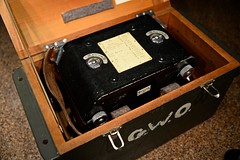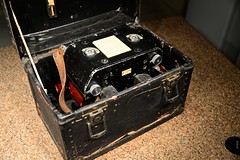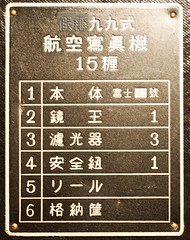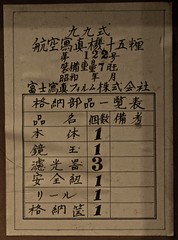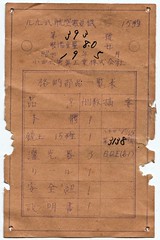Difference between revisions of "User:Heritagefutures/WorkSpace"
(→Navy Handheld Aerial Camera 25cm F-8 type) |
|||
| Line 14: | Line 14: | ||
= Navy Handheld Aerial Camera 25cm F-8 type = | = Navy Handheld Aerial Camera 25cm F-8 type = | ||
| − | The '''Handheld Aerial Camera 25cm F-8 type''' (手持式航空写真機25cm F-8型) was made for the Japanese Navy by [[Konica|Rokuoh-sha]], later [[Konica|Konishiroku]].<REF name="JNP p8"> | + | The '''Handheld Aerial Camera 25cm F-8 type''' (手持式航空写真機25cm F-8型) was made for the Japanese Navy by [[Konica|Rokuoh-sha]], later [[Konica|Konishiroku]].<REF name="JNP p8"><i>Japanese Naval Photography</i>. Compiled by Lt W.D.Hedden, USNR, with LtCdr G.Z.Dimitroff USNR and Lt(jg) W.A. Seymour, USNR. Intelligence Targets Japan (DNI) of 4 September 1945. Facicle A-1, Target A-39. U.S. Naval Technical Mission to Japan. December 1945. pp.8-9.</REF><REF name="Wetwing Aerial"> [http://www.wetwing.com/aerialcamera/aerialcameras/cameras.html Aerial camera types] at Wetwing Aerial Camera. </REF><REF name="Iwama p55"> Iwama, pp.55 of {{KKS}} no.10. </REF> The camera was essentially a copy of the American [[Fairchild F-8]]. Additionally, original Fairchild F-8 cameras reputedly also found use by the Japanese Navy.<REF> ''Japanese Naval Photography'', p.7. </REF> |
| − | Recent Japanese sources | + | Recent Japanese sources claim that the camera was made from 1924 (or 1925) to 1938.<REF>1924 to 1938: [http://www.wetwing.com/aerialcamera/aerialcameras/cameras.html Aerial camera types] at Wetwing Aerial Camera. 1925 to 1938: Iwama, pp.55 of {{KKS}} no.10. </REF> This is a rsult of the confusion of the various types of 25cm cameras used by the Japanese armed forces. The early models, itroduced in 1924/5 were the However, a report from the U.S. Naval Technical Mission to Japan, written in December 1945, gives detailed production figures for the Konishiroku F-8 in the 1941–1945 period, summarized in the following table:<REF name="JNP p8" /> |
{| border="1" cellpadding="4" style="margin: 0.5em 2em; text-align: center; border-collapse: collapse;" | {| border="1" cellpadding="4" style="margin: 0.5em 2em; text-align: center; border-collapse: collapse;" | ||
Revision as of 09:42, 25 July 2012
Contents
Handheld Aerial Camera 25cm / Nedinsco type
The first aerial camera used by the Japanese air forces in some quantity was the Nedinsco FK I.[1] (Nedinsco was a Dutch branch of Carl Zeiss, and "FK" perhaps means Fliegerkamera.) It was adopted by the Japanese Army as the 25cm Aerial Camera (二十五糎航空写真機),[1] named after its 25cm focal length. It was also used by the Navy as the Handheld Aerial Camera 25cm (手持式航空写真機二五糎).[2]
The Nedinsco camera was later produced in Japan by Rokuoh-sha,[1] perhaps after an official license was bought or as an unauthorized copy. Cameras made in the 1930s have a Hexar Ser.1 25cm f/4.5 lens. They were mostly retired from use when the Pacific War broke out.[3]
The camera takes 13×18cm film plates. The rigid body is made of wood, with a characteristic octagonal front section, covered by a cap. There is a built-in grip on the left and a separate wooden handle on the right.
The focal-plane shutter is a separate unit, which can be slid out of the body for maintenance or repair. It has vertically travelling curtains, and the range of speeds is 1/90, 1/180, 1/375 and 1/750.[1][2]
The aperture is set by an index at the top of the camera, in front of the identification plate, with f/4.5, f/6.3 and f/9 positions.[4] There is an articulated mechanism placed around the lens, holding two filters controlled by external knobs on either side of the body.
Notes
The Handheld Aerial Camera 25cm F-8 type (手持式航空写真機25cm F-8型) was made for the Japanese Navy by Rokuoh-sha, later Konishiroku.[1][2][3] The camera was essentially a copy of the American Fairchild F-8. Additionally, original Fairchild F-8 cameras reputedly also found use by the Japanese Navy.[4]
Recent Japanese sources claim that the camera was made from 1924 (or 1925) to 1938.[5] This is a rsult of the confusion of the various types of 25cm cameras used by the Japanese armed forces. The early models, itroduced in 1924/5 were the However, a report from the U.S. Naval Technical Mission to Japan, written in December 1945, gives detailed production figures for the Konishiroku F-8 in the 1941–1945 period, summarized in the following table:[1]
| Year | 1941 | 1942 | 1943 | 1944 | 1945 | Total |
| Ordered | 400 | 500 | 640 | 1044 | 1080 | 3664 |
| Delivered | 286 | 403 | 698 | 787 | 142 | 2316 |
It is plausible that the F-8 type replaced the Nedinsco type as the standard hand-held camera in 13×18cm format for the Navy, and it seems reasonable to assume that the first examples were made in the mid to late 1930s.
The F-8 type takes 13×18cm exposures. The 1945 American report says that the early examples were taking six glass plates within a magazine, but the camera was modified to use rollfilm "early in the war".[6] All the surviving examples known so far take 18cm wide film rolls.[2][3] The rolls were normally 3.7m long, allowing for 25 frames,[2] but double-length 7.5m rolls were manufactured in 1943 and 1944.[7][8]
The camera body is made of metal. The shutter is of the focal-plane type, with 1/60, 1/100, 1/160, 1/200, 1/300 and 1/400 speeds.[2] When rotated, the right handle advances the film, winds the shutter and advances the exposure counter in a single movement.[3] There is a folding frame finder at the top, of which variations are known.
If we accept the 1924 or 1925 release date given by some Japanese sources (see above), the early examples made until the early 1930s certainly had an imported German lens. The examples found today normally have a Hexar Ser.1 25cm f/4.5 (same as mounted on the Nedinsco type), sometimes with abbreviated markings Hexar.1 4.5 25.
Surviving examples
Surviving examples have been observed in two main variants.
Early Models
The first variant[9] has a large black identification plate, with the camera's official name in Japanese characters (手持手持式航空寫眞機25cm F-8型), a serial number, the year and month of manufacture, and the words Tokyo (東京) and Rokuoh-sha (六櫻社). There is a small housing on the left side, behind the left handle. There is no control lever above the camera, and the aperture is perhaps directly controlled by turning a ring around the lens. Finally, there are four screw threads at the front of the main body, probably provided to attach the camera to a fixed aircraft mount. The December 1945 American report says that attempts were made to use the F-8 type as a vertical camera, and about 25 mounts were produced for the C6N Saiun (Myrt) reconnaissance plane, but the trials were not satisfactory and the camera was only used hand-held.[6]
Late Models
The second variant[10] is presumably later. It has a small white plate with Rokuoh-sha or Konishiroku's logo (the character roku 六 inside a stylized cherry blossom) and a serial number. Two levers are visible at the top, in front of the frame finder. The front lever controls the aperture and has three positions: 4.5, 6.3 and 9. The second lever was used to compensate for proper focus with infra-red film.[6] The small housing on the left side and the four screw threads at the front are no longer present.
Notes
- ↑ 1.0 1.1 Japanese Naval Photography. Compiled by Lt W.D.Hedden, USNR, with LtCdr G.Z.Dimitroff USNR and Lt(jg) W.A. Seymour, USNR. Intelligence Targets Japan (DNI) of 4 September 1945. Facicle A-1, Target A-39. U.S. Naval Technical Mission to Japan. December 1945. pp.8-9.
- ↑ 2.0 2.1 2.2 2.3 Aerial camera types at Wetwing Aerial Camera.
- ↑ 3.0 3.1 3.2 Iwama, pp.55 of Kurashikku Kamera Senka no.10.
- ↑ Japanese Naval Photography, p.7.
- ↑ 1924 to 1938: Aerial camera types at Wetwing Aerial Camera. 1925 to 1938: Iwama, pp.55 of Kurashikku Kamera Senka no.10.
- ↑ 6.0 6.1 6.2 Japanese Naval Photography, p.10, repeated in this page at Airrecce
- ↑ Japanese Naval Photography, p.18.
- ↑ Iwama, p.55 of Kurashikku Kamera Senka no.10, says 6m, but this is certainly a confusion with the 18cm × 6m rolls used in some Army cameras, see Japanese Naval Photography, p.18.
- ↑ Examples pictured in this WorthPoint entry (with Rokuoh-sha Tokyo Hexar Ser.1 25cm f/4.5 lens no.5382), and in this page and this page at Wetwing Aerial Camera (with serial no.1176).
- ↑ Examples pictured in this page at Airrecce, and in F-8 this page of the NASM.
The Navy Field Camera (21cm & 36cm) (¶¶¶) was produced for the Japanese Navy by Rokuoh-sha( (六桜社) ) / Konishiroku) (小西六)[1]
f/4.5 21cm or 36cm , plate size 12 x 16.5 (nominally)
discuss relationship to Army camera
A report from the U.S. Naval Technical Mission to Japan, written in December 1945, gives detailed production figures (Table 1), showing that the camera was introduced in 1942.[1] The dramatic drop of actual deliveries compared or orders in 1945 shows the impact of the Allied bombing on specialised camera production.
Table 1 Production volume of Navy Field Cameras for the period 1941-1945[1]
| Year | 1941 | 1942 | 1943 | 1944 | 1945 | Total |
| 21cm model | ||||||
| Ordered | — | 150 | 150 | 300 | 300 | 900 |
| Delivered | — | 127 | 28 | 293 | 20 | 468 |
| 36cm model | ||||||
| Ordered | — | 80 | 100 | 120 | 120 | 420 |
| Delivered | — | 55 | 124 | 3 | — | 182 |
Notes
Army Type B Field Camera
The Army Type B Field Camera (21cm) (¶¶¶) was produced for the Japanese Army by Rokuoh-sha( (六桜社) ) / Konishiroku) (小西六)[1]
discuss relationship to Navy camera
A report from the U.S. Naval Technical Mission to Japan, written in December 1945, gives detailed production figures (Table 1), showing that the camera was introduced in 1941.[1] f/4.5 21cm , plate size 12 x 16.5 (nominally)
Table 1 Production volume of Army Type B Field Camera for the period 1941-1945[1]
| Year | 1941 | 1942 | 1943 | 1944 | 1945 | Total |
| Ordered | 75 | 125 | 50 | 50 | — | 300 |
| Delivered | 50 | 100 | — | 100 | — | 250 |
Notes
As was custom with all Japanese military camera gear, the the Type 99 Handheld Aerial Cameras (15cm) (九九式航空写真機十五糎) were supplied as a set complete with all the required paraphernalia (such as filters, additional magazines etc).
Storage Boxes
Table 1 Shape of boxes
| Type | Manufacturer (of camera) |
Serial number (range) Date (if known) |
Material | Dimensions (L x B x H) | External View | Internal View | ||||
| Type 1 | Fuji Shashin Film | 62 | Plywood with leather covering |
|
| |||||
| Type 2 | Fuji Shashin Film | sn#122[1] | Wood |
|
| |||||
| Type 3 | Rokuoh-sha | sn#393 | Plywood with leather covering |
|
| |||||
| images by Dirk HR Spennemann (Image rights) | ||||||||||
Packaging Lists
To ensure that store personnel could account for the contents of the sets, camera manufacturers affixed content labels on the insides of the storage boxes. These labels were made of aluminum, printed paper or (cheaper) duplication by mimeograph or Whiteprint.
Table 2 Packing Labels (Lists of Contents)
| Type | Manufacturer of Camera | Serial number (range) | Material | Date (if known) | |||
| Type 1 | Fuji Shashin Film | 62 | Aluminium |
| |||
| Type 2 | Fuji Shashin Film | Paper, printed Type-set Kanji Characters |
|||||
| Type 3 | Fuji Shashin Film | 122 | Paper, mimeographed[2] Hand-written Kanji Characters |
| |||
| Type 4 | Rokuoh-sha | Paper, printed Type-set Kanji Characters |
|||||
| Type 5 | Rokuoh-sha | 393 | Paper, Whiteprint ('diazo')[3] Hand-written Kanji Characters |
1944 (May) |
| ||
| images by Dirk HR Spennemann (Image rights) | |||||||
Notes
- ↑ The camera that came with the case is a Rokuoh-sha-built unit sn#1257, but the paper label in the lid shows that the box belonged to a Fuji Shashin Film-built unit sn#122.
- ↑ See this Wikipedia entry for the duplication technique.
- ↑ See this Wikipedia entry for the duplication technique.


